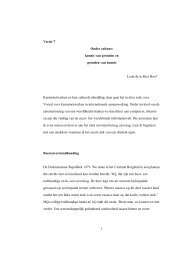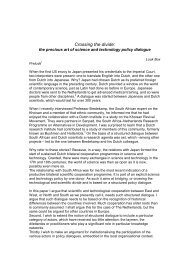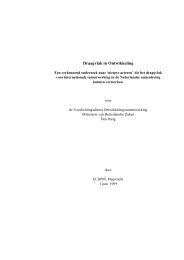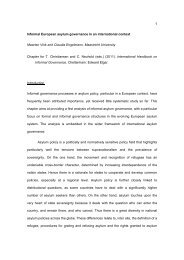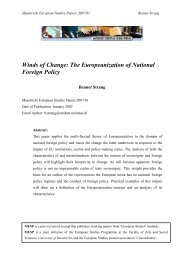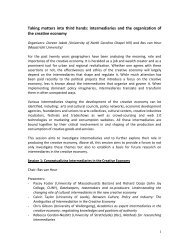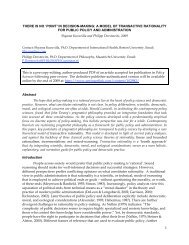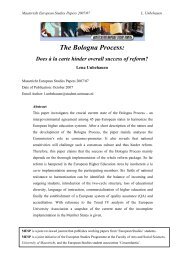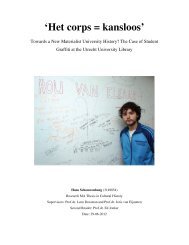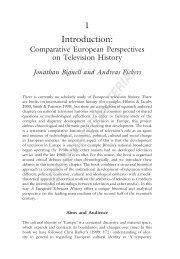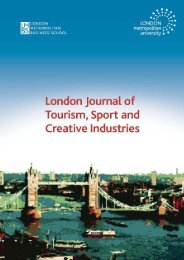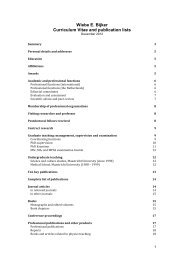the case of the synthetic dye industry, 1857–1914 - Maastricht ...
the case of the synthetic dye industry, 1857–1914 - Maastricht ...
the case of the synthetic dye industry, 1857–1914 - Maastricht ...
Create successful ePaper yourself
Turn your PDF publications into a flip-book with our unique Google optimized e-Paper software.
184 J.P. Murmann and E. Homburg<br />
with relatively minor fluctuations until <strong>the</strong> First World War. If one also counts<br />
German-owned plants in foreign countries, German market share reached as high<br />
as 90% (Thissen, 1922).<br />
Concentration processes also occurred within national industries after <strong>the</strong><br />
1860s. In all major countries output became increasingly held in <strong>the</strong> hands <strong>of</strong> a<br />
few firms. These firms were all relatively early entrants. Britain, Germany, and<br />
<strong>the</strong> USA illustrate this trend. In Germany <strong>the</strong> top three producers accounted for<br />
55% <strong>of</strong> <strong>the</strong> 60 million marks domestic <strong>dye</strong> production in 1883. More specifically,<br />
BASF had a market share <strong>of</strong> 23.3%, Hoechst <strong>of</strong> 16.7% and Bayer <strong>of</strong> 15% (Meyer-<br />
Thurow 1982). In 1914, <strong>the</strong> top three producers accounted for 66% <strong>of</strong> domestic<br />
production. BASF, Bayer, and Hoechst were each responsible for about 22% <strong>of</strong><br />
domestic production and, given Germany’s world market share, for almost 20%<br />
<strong>of</strong> world production each. 8 At <strong>the</strong> start <strong>of</strong> <strong>the</strong> First World War, Levinstein and<br />
Read Holliday also possessed a dominant position among domestic producers in<br />
Great Britain with a share <strong>of</strong> about 30% each <strong>of</strong> British production. 9 At this time,<br />
in <strong>the</strong> U.S., Schoellkopf held a 50% share <strong>of</strong> domestic <strong>dye</strong> production, Heller<br />
& Merz had 21%, and <strong>the</strong> Bayer subsidiary, Hudson River Aniline, had 17%<br />
(Haynes, 1954, p. 313).<br />
Important drivers behind <strong>the</strong>se concentration tendencies were economies <strong>of</strong><br />
scope and to a lesser extent economies <strong>of</strong> scale. The <strong>case</strong> <strong>of</strong> Bayer, a firm that<br />
became one <strong>of</strong> <strong>the</strong> three largest German <strong>dye</strong> producers, illustrates <strong>the</strong> process<br />
<strong>of</strong> exploiting scope and scale economies. Bayer achieved unit cost reductions<br />
through a variety <strong>of</strong> ways. Over <strong>the</strong> years it increased <strong>the</strong> size <strong>of</strong> production<br />
reactors by several orders <strong>of</strong> magnitude. In 1868 Bayer used autoclaves with a<br />
capacity <strong>of</strong> 30 liters; by 1905 it used 2000-liter autoclaves (Bayer, 1918, pp.<br />
251-252). At <strong>the</strong> beginning <strong>of</strong> <strong>the</strong> azo <strong>dye</strong> era, Bayer reactors had at most a size<br />
<strong>of</strong> between 1000 and 2000 liters (Bayer, 1918, p. 182). By 1907 a reactor to<br />
make azo <strong>dye</strong> had a capacity <strong>of</strong> 20,000 liters (Bayer, 1918, p. 182).<br />
These economies applied not only to production but to R&D as well. (See also<br />
Chandler, 1990, on <strong>the</strong> importance <strong>of</strong> scale and scope economies in o<strong>the</strong>r industries.)<br />
In <strong>the</strong> era where firms’ R&D laboratories replaced university laboratories<br />
as <strong>the</strong> main source <strong>of</strong> new <strong>dye</strong>s, large-scale experimentation and testing <strong>of</strong> <strong>dye</strong>s<br />
reduced <strong>the</strong> cost <strong>of</strong> finding competitive new <strong>dye</strong>s. In 1906, Meyer-Thurow (1982)<br />
reports, 2,656 new chemical compounds were syn<strong>the</strong>sized in Bayer’s research<br />
laboratories. Sixty <strong>of</strong> those were tested on a larger scale after a first screening,<br />
and only 36 ever reached <strong>the</strong> market. 10 Syn<strong>the</strong>sizing only a few new molecules<br />
and testing some <strong>of</strong> <strong>the</strong>m for <strong>the</strong>ir usability on different fabrics was likely to yield<br />
8 The latter figure is calculated from data provided in Redlich (1914, p. 18) and Beer (1959, p.<br />
138).<br />
9 It is very difficult to come by exact numbers on British market shares. We have estimated this<br />
figure from <strong>the</strong> information that Levinstein and Read Holliday were <strong>the</strong> two largest <strong>dye</strong> firms <strong>of</strong><br />
comparable size (Reader, 1954, p. 263) and that after <strong>the</strong>ir merger <strong>the</strong> combined firm held about<br />
75% <strong>of</strong> domestic production in 1918 (Richardson, 1962, p. 117).<br />
10 Hoechst, besides BASF, Bayer’s biggest rival, developed a similar testing organization. In 1900<br />
Hoechst tested 3,500 <strong>of</strong> its new colors or combination <strong>of</strong> old colors. Only 18 reached <strong>the</strong> market. A<br />
few years later 29 out <strong>of</strong> 8000 tested <strong>dye</strong>s were marketed (Beer, 1959, p. 89).



